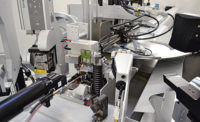One of the biggest challenges in manufacturing today is obtaining and retaining skilled labor. Wire harness manufacturing is no exception. In fact, one online job board listed more than 900 openings for wire harness assemblers in March.
Training all those new workers quickly will be imperative. Now, IPC and the Wiring Harness Manufacturer’s Association (WHMA) have developed a new training program that promises to help harness manufacturers do just that.
The program, Wire Harness Assembly for Operators (WHO), is designed to teach workers about the tools, materials and processes needed to assemble, inspect and test wire harnesses. The program consists of 14 modules. The first seven modules are mandatory and cover subject areas that are critical for every harness assembler to know. These include safety; engineering documentation; materials and components; tools and equipment; wire preparation and processing; and inspection and testing.
The remaining seven modules are optional and include more detailed information about specific job-related tasks or technologies. These modules cover crimp terminations; soldered terminations; splicing; connector assembly; coaxial cable; labeling, securing and covering; and finished assembly installation.
Students who complete the mandatory modules and at least one of the optional modules earn an IPC certificate that identifies them as a “qualified IPC wire harness operator.” Valid for two years, these certificates are serialized with a unique identification number that employers can check for verification.
WHO is not intended to provide certification on the IPC/WHMA-A-620 Requirements and Acceptance for Cable and Wire Harness Assemblies Standard as either a specialist or a trainer.
“Certification has been the heart of our education programs for the past several decades, but there were challenges in the industry that certification wasn’t solving,” admits Dave Hernandez, vice president of education at IPC. “Certification is critical in helping manufacturers retain skilled workers, because it helps to identify people with a certain level of knowledge, but it doesn’t necessarily help develop or obtain new talent. It doesn’t necessarily provide basic skills training on how to do a job.”
Students can complete the course at their own pace, from any location, on any Internet-connected device. Students can access the course 24/7, and the software remembers where each student left off.
“There’s also an in-person version of the program, in which we provide an instructor at a manufacturer all the content needed to teach the program in a classroom setting,” says Hernandez. “Students can still access the online activities and assessments to do their individual work.”
Some manufacturers might prefer to take a hybrid approach. “We see this with our Electronics Assembly for Operators training program,” says Hernandez. “Teachers will assign students a section of the course to learn on their own, and then the instructor will come back and teach the material to everyone together.”
The course can be completed online, in person, or a combination of both. The online version includes virtual instructors—professional voice actors teach the lessons—photography, video and animations. Each module also contains a vocabulary to which students can refer.
The WHO program fills that need. The program’s modular structure allows manufacturers to implement the course to suit their needs. For example, workers can complete all 14 modules or just the first seven and only those optional modules that relate directly to their specific jobs.
A Year in the Making
The program took more than a year to develop. IPC and WHMA worked with subject-matter experts from some 40 wire harness manufacturers, who helped the organizations identify the knowledge and skills that assemblers need to do their jobs.
“This program would not exist today were it not for participation by WHMA members,” says Hernandez. “They have been extraordinary.”
Once a framework for the program was developed, IPC and WHMA convened a smaller group of subject-matter experts from the industry to help write and review the content.
IPC and WHMA took a user-centered approach to module design. Each module is fairly short and divided into subsections. The longest one might take two hours to complete.
“The whole idea of the subsections is to make it easy for students to absorb and easy for manufacturers to implement,” explains Hernandez. “Manufacturers can have students take the course all at once, or they can have students learn in half-hour blocks over several weeks.”
Each module has a pre- and post-assessment quiz. The pre-assessment is designed to help students understand how much they know about a particular topic.
“It’s also a way to prime the student to learn what’s in the module,” says Carlos Plaza, senior director of education development at IPC. “The questions put key concepts at the forefront of your mind, so when you see those concepts in the module, you’re ready to remember that information.”
The post-assessment measures how much the students have learned and reteaches a concept when needed. Students cannot advance to the next module until they understand the previous material.
“In the post-assessment, if you get a question wrong, you are invited to click a review button, which opens up a window with text that goes over the topic again,” explains Hernandez.
Each program has optional hands-on activities to reinforce what has been taught. “We leave those up to each organization to determine what makes sense,” he says. “Students can do the activity on their own at the end of the module, or manufacturers can wait for several students to finish and do the activity as a group. Students can do a couple of modules in the classroom, and then they spend half a day on the shop floor.”
Now, the WHO program is in beta testing. IPC and WHMA invited a sample of experienced and inexperienced assemblers, as well as supervisors, to run through the modules and provide feedback. “This process is really important, because it helps to work out the kinks,” says Plaza.
The course is expected to be finalized by the end of April. At press time, the IPC had not set a price on the training. However, the Electronics Assembly for Operators training program cost $200 for IPC members and $275 for nonmembers.
Assembly Training is ‘BEST’
The IPC isn’t the only organization offering training programs for wire harness assemblers. BEST Inc., a for-profit training company, also offers a comprehensive course on wire harness assembly.
Based in the Chicago area, BEST (short for Business Electronic Soldering Technologies) certifies instructors and technicians in various IPC certification programs. The company has a several training centers throughout the Midwest and South, as well as a mobile training center. BEST also offers custom courses on manual soldering and circuit board rework.
Like the IPC’s training program, BEST’s Cable and Wire Harness Assembly Course is intended to give people practical hands-on experience in wire harness assembly. It is not designed to provide certification on the IPC/WHMA-A-620 standard as either a specialist or a trainer.
The two-day course consists of eight modules that cover how to read harness drawings and cut lists; wire preparation; coaxial terminations; pin-crimp terminations; insulation-displacement terminations; wire splicing; lug crimp terminations; and taping and bundling.
The course is taught through a series of hands-on labs. Students can attend the entire course, or BEST can tailor the course to suit the specific training needs of a company. Students use industry-standard tools, including wire cutters, strippers, soldering irons and test equipment The course is structured in accordance to the IPC/WHMA-A-620 standard, so students should have a working knowledge of the standard prior to enrollment.
For the final part of the course, students will need to assemble a complete wire harness from start to finish.
This class can be held at a BEST training site, or it can be taught on-location via the mobile training center. Graduates of the class will receive a certificate of completion from BEST.
The next scheduled class will be May 10-11. For more information, call BEST at 847-797-9250 or visit www.solder.net.







